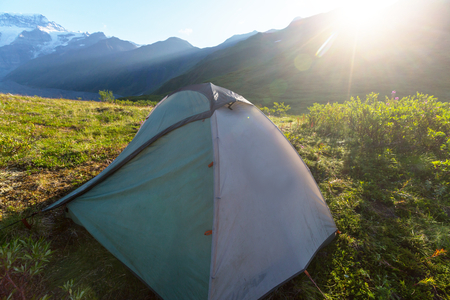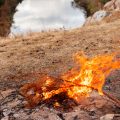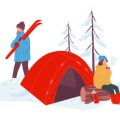1. Why a First Aid Kit is Essential for Every Camping Trip
When youre out in the wild, whether its a weekend at a local state park or a backcountry adventure, having a well-stocked first aid kit isnt just a good idea — its an absolute must. The outdoors can be unpredictable, and even a small accident can turn serious without the right supplies on hand. A first aid kit gives you the ability to respond quickly to injuries and emergencies when help might be hours away.
Accidents Happen – Even to the Most Experienced Campers
No matter how prepared or careful you are, nature has its own agenda. Something as simple as tripping over a tree root or brushing against poison ivy can cause discomfort or injury. Here are some common camping situations where a first aid kit can really make a difference:
| Scenario | Why You Need a First Aid Kit |
|---|---|
| Cuts and Scrapes from Hiking | You’ll need antiseptic wipes, bandages, and antibiotic ointment to prevent infection. |
| Bites from Insects or Ticks | Tweezers for tick removal, anti-itch cream, and antihistamines are essentials. |
| Burns from Campfires or Cooking Gear | Burn cream and sterile dressings help reduce pain and risk of infection. |
| Blisters from Long Treks | Moleskin or blister pads keep you moving without pain. |
| Sprains or Strains While Exploring | An elastic bandage and cold pack can offer quick relief until proper care is available. |
| Allergic Reactions (e.g., bee stings) | An epinephrine auto-injector (if prescribed) or antihistamines may be life-saving. |
The Nearest Help Might Be Miles Away
If youre deep into the woods or camping off-grid, emergency medical services could take hours to reach you—or you might have to hike out on your own. A well-prepared first aid kit helps bridge that gap by allowing you to treat wounds, manage pain, or stabilize someone until professional help arrives.
A Basic Kit Isn’t Always Enough
A store-bought basic first aid kit may not cover all your needs while camping. Outdoor adventures often require extras like bug spray, sunscreen, water purification tablets, and even emergency medications. Customizing your kit based on your destination, group size, and planned activities ensures youre ready for anything.
2. Must-Have First Aid Kit Essentials for Campers
When youre out in the wild, far from pharmacies or urgent care centers, having the right first aid supplies can make a big difference. Whether you’re dealing with scrapes, stings, or something more serious, your camping first aid kit should be stocked with essentials that are both versatile and practical. Below, we break down the core items every camper should have—and why they matter.
Basic Wound Care Supplies
Minor cuts, scrapes, and blisters are common while camping. These items help clean and protect wounds to prevent infection:
| Item | Why Its Important |
|---|---|
| Adhesive Bandages (various sizes) | Cover small cuts and prevent dirt or bacteria from getting in. |
| Sterile Gauze Pads | Useful for covering larger wounds or stopping bleeding. |
| Medical Tape | Keeps gauze in place securely. |
| Antiseptic Wipes | Cleans wounds before dressing them—reduces risk of infection. |
| Antibiotic Ointment (like Neosporin) | Aids in healing and prevents infection in minor cuts and abrasions. |
Pain Relief & Allergy Medications
From headaches to bug bites, having a few over-the-counter meds on hand is always a good idea:
| Item | Why Its Important |
|---|---|
| Ibuprofen or Acetaminophen | Reduces pain, fever, and inflammation—helpful after long hikes or injuries. |
| Antihistamines (like Benadryl) | Treats allergic reactions from insect bites, plants like poison ivy, or food allergies. |
| Hydrocortisone Cream | Soothes itching and skin irritation caused by bites or rashes. |
Essential Tools for Emergency Situations
The right tools can help you handle everything from removing splinters to cutting bandages:
| Item | Why Its Important |
|---|---|
| Tweezers | Removes splinters, ticks, or debris from wounds safely. |
| Trauma Shears (Medical Scissors) | Easily cuts through clothing or bandages during emergencies. |
| Digital Thermometer | Helps monitor body temperature if someone feels unwell or has a fever. |
| SAM Splint (optional but useful) | A lightweight way to stabilize fractures or sprains until professional help is available. |
| Nitrile Gloves (non-latex) | Keeps things sanitary when treating wounds—especially important for group camping trips. |
Specialty Items for Outdoor Needs
Certain items are especially handy when youre deep in nature:
| Item | Why Its Important |
|---|---|
| Moleskin Padding | Prevents and relieves blisters—ideal for hikers and backpackers. |
| Bite & Sting Relief Pads or Pens | Eases discomfort from mosquito bites, bee stings, or spider bites. |
| Aloe Vera Gel Packets | Treats mild sunburns—great for summer camping trips. |
| Emergency Blanket (Mylar) | Keeps someone warm in case of shock or sudden cold weather exposure. |
| Duct Tape (small roll) | A surprisingly versatile tool—from securing bandages to temporary gear fixes. |
Labeling & Organization Tips
A well-organized first aid kit helps you act quickly during an emergency. Use small waterproof bags or pouches to separate items by category (e.g., wound care, meds, tools). Label each section clearly so anyone in your group can find what they need fast—even under stress or low light conditions.
Your First Step Toward Safer Camping Adventures
Packing these must-haves ensures youre ready for most minor injuries and unexpected situations that come with outdoor living. In the next section, we’ll explore how to customize your first aid kit based on your trip length, group size, and destination type.
![]()
3. Special Considerations for Wilderness First Aid
When you’re camping deep in the backcountry or far from immediate help, your first aid kit needs more than just the basics. In remote areas, minor injuries can quickly turn into major problems if youre not prepared. Here are some special items and why they matter when youre miles away from the nearest clinic or cell signal.
Essential Wilderness-Specific Items
Standard first aid kits are great for most campgrounds, but once you head into the wilderness, you need to be ready for more serious situations. These additions could make a big difference:
| Item | Why You Need It |
|---|---|
| Splints (foldable or SAM splint) | Useful for stabilizing sprains or broken bones until professional help is available. |
| Emergency Blanket (Mylar) | Helps prevent hypothermia by retaining body heat; also useful as shelter or signaling device. |
| Epinephrine Auto-Injector (EpiPen) | Critical for treating severe allergic reactions from insect stings, food, or plants. |
| Snake Bite Kit | Especially important in areas where venomous snakes are common. Be sure to know how to use it properly. |
| Water Purification Tablets | Diarrhea and dehydration can become medical emergencies in the wild—safe water helps prevent that. |
| Tweezers and Tick Remover Tool | Ticks can carry Lyme disease; quick removal reduces risk of infection. |
Know Before You Go
Packing the right gear is only half the battle—knowing how and when to use it is just as important. Before heading out, take a basic wilderness first aid course or watch instructional videos on using tools like splints and EpiPens. Also, research local wildlife, terrain, and weather conditions so you can pack accordingly.
Pro Tip:
If you’re hiking in snake country (like parts of the Southwest), keep your snake bite kit in an easy-to-reach spot in your backpack—not buried at the bottom!
Customize Based on Destination
Your first aid kit should reflect where youre going and what youre doing. A trip to a high-altitude mountain range will need different supplies than a desert hike or forest camping weekend. Adjust your pack based on:
- Climate: Cold-weather trips may require extra blankets or frostbite treatments.
- Altitude: Include medication for altitude sickness if heading above 8,000 feet.
- Wildlife risks: Pack bear spray or allergy meds depending on local fauna.
Your Wilderness Safety Checklist:
- [ ] Splint for immobilizing limbs
- [ ] Emergency blanket for warmth and signaling
- [ ] EpiPen (if needed)
- [ ] Snake bite kit (if applicable)
- [ ] Water purification tablets or filter
- [ ] Tick remover tool
- [ ] Extra doses of prescription medications
- [ ] Printed emergency contact info and medical history card
The deeper into nature you go, the more self-sufficient you need to be. Adding these special items to your camping first aid kit gives you peace of mind—and potentially life-saving tools—when youre off the grid.
4. Tailoring Your Kit to Your Adventure
When it comes to building the perfect first aid kit for camping, one size definitely doesnt fit all. The gear you pack should reflect your specific plans—where youre going, how long youll be gone, who youre going with, and what kind of activities youll be doing. Customizing your kit can make a big difference in handling unexpected situations efficiently.
Consider Your Destination
The location of your camping trip plays a major role in what you need to bring. Are you heading into the mountains, desert, forest, or coastal area? Each environment presents unique challenges.
| Environment | Special Considerations |
|---|---|
| Mountains | Add altitude sickness tablets and extra warm packs |
| Desert | Packing electrolyte tablets and sunburn relief is key |
| Forest | Tweezers for splinters, insect bite cream, and tick removal tools are helpful |
| Coastal Areas | Add vinegar for jellyfish stings and waterproof bandages |
Think About Group Size
A solo camper will need a much smaller kit than a family of five or a group of friends. The more people on the trip, the more supplies youll need—especially items like adhesive bandages, antiseptic wipes, and pain relievers.
| Group Size | Packing Tips |
|---|---|
| Solo Camper | A compact kit with essentials like gauze, tape, antiseptic wipes, and a few medications |
| Duo or Small Group (2–4) | Add extra quantities of basics plus blister care and allergy meds |
| Larger Groups (5+) | A more robust kit with duplicates of key items; consider an emergency splint and digital thermometer |
Factor in Trip Length
The longer your adventure lasts, the more likely someone will need medical attention at some point. Replenish items that run out quickly and add medications for common issues like stomach upset or headaches.
- Weekend Trips: A basic kit with first aid must-haves should suffice.
- Week-Long Adventures: Include extra doses of any daily medications, additional wound care supplies, and cold/flu remedies.
- Extended Trips (1 week+): Pack a mini “field pharmacy” with antibiotics (if prescribed), burn cream, antihistamines, and more comprehensive tools like scissors or tweezers.
Your Activities Matter
If youre planning specific outdoor adventures during your camping trip—like hiking rugged trails, kayaking through rivers, or mountain biking across rocky paths—you’ll want to tailor your kit accordingly.
| Activity | Add These Items |
|---|---|
| Hiking | Moleskin for blisters, ankle wraps, insect repellent wipes |
| Kajaking/Canoeing | Dramamine for motion sickness, waterproof bandages, dry bag for storing medical supplies |
| Biking/Mountain Biking | Tegaderm dressings for road rash, instant cold packs, elastic bandages for sprains |
A Quick Checklist to Customize Your Kit:
- Select a durable case that fits your travel style (waterproof for wet areas)
- Add personal medications with extra doses just in case
- Packing for kids? Include child-friendly pain relievers and fun bandages to ease stress
- If pets are joining the trip, bring pet-safe antiseptic and paw protection ointment
The key takeaway: Dont just grab a pre-made kit off the shelf—use it as a foundation and build on it based on your unique needs. Being thoughtful now can save you serious headaches later when youre far from help.
5. Tips for Packing, Storing, and Maintaining Your First Aid Kit
Keeping your first aid kit organized and ready to go is just as important as whats inside it. A well-maintained kit can make all the difference in an emergency situation, especially when youre far from help out in the wilderness. Heres how to make sure your camping first aid kit is always ready when you need it most.
Stay Organized: Group Items by Use
Sorting your supplies into categories can save you precious time during emergencies. Use small ziplock bags or labeled pouches to group similar items together. Here’s a simple way to organize your kit:
| Category | Contents |
|---|---|
| Wound Care | Bandages, gauze pads, antiseptic wipes, antibiotic ointment |
| Pain & Fever Relief | Ibuprofen, acetaminophen, cold compress |
| Allergy & Bites | Antihistamines, hydrocortisone cream, insect sting relief wipes |
| Tools | Tweezers, scissors, medical tape, gloves |
| Personal Medications | Prescription meds, EpiPen (if needed) |
Choose the Right Storage Container
Your container should be durable, waterproof, and easy to carry. Hard-shell cases or heavy-duty nylon pouches with compartments work great for outdoor use. Make sure it’s clearly marked and easy to spot among your gear.
Pro Tip:
If youre hiking or backpacking, consider a smaller version of your main kit that fits in a daypack for easy access on the trail.
Store It Smartly at Camp
At your campsite, keep the first aid kit in a central and easily accessible location—preferably somewhere dry and shaded. Everyone in your group should know where its stored in case of an emergency.
Regular Maintenance: Check Often!
A first aid kit is only useful if everything inside works and is up-to-date. Use this checklist to stay on top of maintenance:
| Maintenance Task | How Often? |
|---|---|
| Check expiration dates on medications and ointments | Every 6 months |
| Replenish used items after every trip | Immediately after return |
| Inspect tools like scissors and tweezers for rust/damage | Before each trip |
| Review contents against checklist to ensure nothings missing | Seasonally or before big trips |
Add a Personal Touch
No two campers are the same, so tailor your kit to fit your group’s specific needs. If someone has allergies or a chronic condition, make sure their essentials are included—and labeled clearly.
Quick Reminder:
A well-packed and maintained first aid kit brings peace of mind. Take the time to prep it properly—you’ll thank yourself later.


